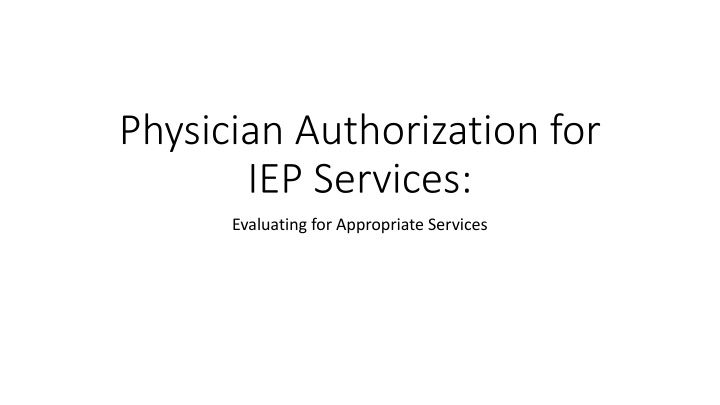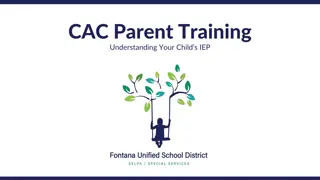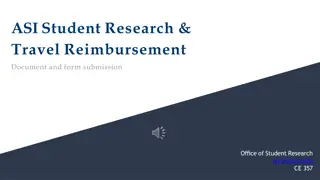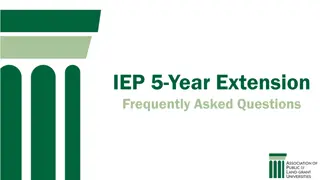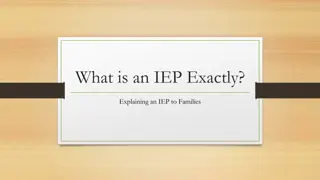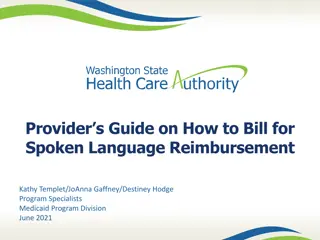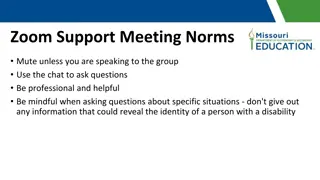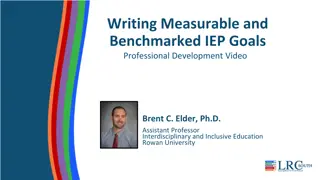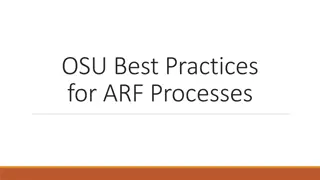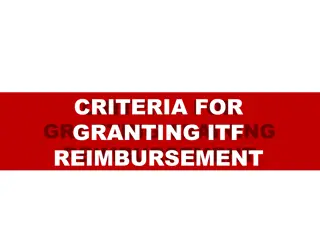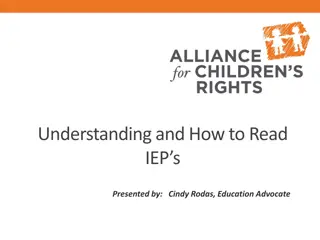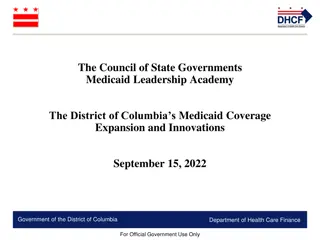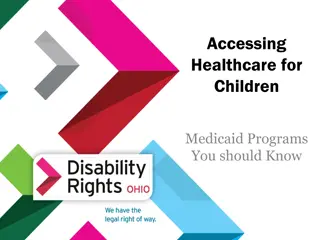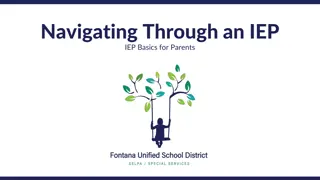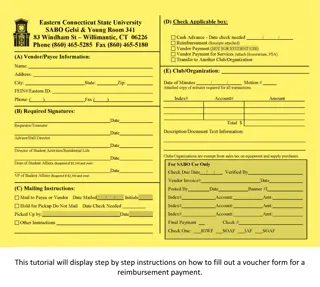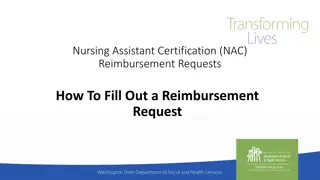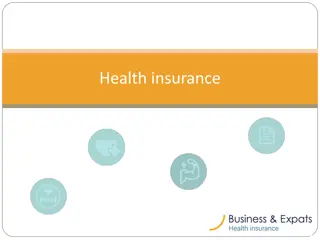Evaluating Appropriateness of IEP Services for Medicaid Reimbursement
Medicaid School-Based Health Services Program in the State of VT utilizes Physician Authorization to ensure medically necessary services in Individualized Education Programs. Evaluating Child's School Documentation for Medical Necessity involves questioning the condition, type, effectiveness, and appropriateness of the requested services. Understanding the distinction between Educational Necessity and Educational Relevance is crucial in determining the essentiality of services. It is important to review IEPs carefully and assess the efficacy of requested services based on current medical literature.
Download Presentation

Please find below an Image/Link to download the presentation.
The content on the website is provided AS IS for your information and personal use only. It may not be sold, licensed, or shared on other websites without obtaining consent from the author.If you encounter any issues during the download, it is possible that the publisher has removed the file from their server.
You are allowed to download the files provided on this website for personal or commercial use, subject to the condition that they are used lawfully. All files are the property of their respective owners.
The content on the website is provided AS IS for your information and personal use only. It may not be sold, licensed, or shared on other websites without obtaining consent from the author.
E N D
Presentation Transcript
Physician Authorization for IEP Services: Evaluating for Appropriate Services
The Medicaid School-Based Health Services Program Used by the State of VT to generate Medicaid reimbursement for medically-related services provided to eligible students. In order to bill, Medicaid requires a Physician Authorization form to show that certain services in the Individualized Education Program are medically necessary.
Medical Necessity: the definition Health care services that are appropriate in terms of type, amount, frequency, level, setting, and duration to the beneficiary s diagnosis or condition must be consistent with generally accepted practice parameters and A. help restore or maintain the beneficiary s health; or B. prevent deterioration or palliate the beneficiary s condition; or C. prevent the reasonably likely onset of a health problem or detect an incipient problem. For children: includes a determination that a service is needed to achieve proper growth and development or prevent the onset or worsening of a health condition. Medicaid Rule 7103
Evaluating the Childs School Documentation for Medical Necessity: Questions to Ask Is there a clearly medical condition? ( this is required, to demonstrate medical necessity) Type: Are the requested services effective for the condition documented? Amount, frequency, level, duration: Are these appropriate for the requested services? Setting: Is the school the most appropriate setting for the requested services?
Educational Necessity versus Educational Relevance If the student does not receive [the service as requested], is there a reason to believe that he or she will not be able to receive an appropriate education? (VT DOE Guidelines, 2001) Many services are relevant, but may not be medically necessary.
Type of Services Is the requested service demonstrated to be effective in current, peer reviewed medical literature? Review the IEP carefully! Some of the treatments that do not have adequate support include: Sensory Integration Therapy (including brushing, deep pressure, weighted vests, swings for vestibular stimulation ) Neurodevelopmental Treatment (NDT) Facilitated Communication (including supported typing ) Horseback riding Swimming
Type of Service: Direct, Indirect, or Consultative Direct: provided directly to a student by a qualified professional Indirect: Delivered directly to a student by another person, under the direct supervision of a qualified professional Consultative: the planned communication of information or skills from one person to others including technical assistance, training, monitoring, service coordination, and administrative consultation. Consider: Only as specialized as necessary. (VT DOE Guidelines, 2001)
Amount, frequency, level, and duration What amount of service is required to meet the medically necessary goals? What might be missed from the educational day during the service provision if it is a service provided outside of the classroom ( pull- out service)? The more-is-better approach is misguided because it confuses quantity with value. (VT DOE Guidelines 2001). What can we do to prevent unhealthy dependencies on caregivers? What can we do to encourage full membership in the classroom community? (VT DOE Guidelines 2001).
Setting Is school the most appropriate place for the provision of these services? VT Medicaid covers both school and medical model services, including simultaneously if appropriate. Is the service educationally necessary and relevant? Deliver at School Is the service relevant to the home/community? Deliver at Home Does the family require multiple opportunities for direct training? Deliver at Home Does the child require equipment needed in the home setting? Deliver at Home
Pull Out Services or Push In Services? The goals should be to: Maximize student involvement in the natural school environments: classrooms, recess, cafeteria, bathroom, hallways. Minimize time away from peers, teachers, and other natural supports. An assessment of each appropriate natural environment is needed, to build on the natural supports available.
Summer Services Requirements When ongoing services are essential for a student to reach reasonable educational goals When previous regression has been noted during vacations When severity of disability presents a danger of regression When transition planning requires ongoing school programming
References Vermont Agency of Education School Based Health Services Program Manual, September 2015. http://www.msb-services.com/VT/Guidance/VT_Manual_FY17.pdf. VT Dept of Education Guidelines for Making Decisions about IEP Services 2001.[The first link includes an in-depth, detailed slide show that expands the information provided in the current presentation.] http://www.google.com/url?sa=t&rct=j&q=&esrc=s&source=web&cd=2&ved=0ahUKEwj pqMWnl6bRAhXB5IMKHSV1CCAQFgggMAE&url=http%3A%2F%2Fwww.uvm.edu%2F~cd ci%2Fiepservices%2Fpdfs%2Fiepservices1of8.ppt&usg=AFQjCNF_SN7BGLlRucbx6n2jFsM UVj-ypQ&bvm=bv.142059868,d.eWE. http://scholarworks.uvm.edu/cgi/viewcontent.cgi?article=1007&context=cessfac. Giancreco M et al. Roles of Related Services Personnel in Inclusive Schools (2000). http://www.uvm.edu/~cdci/archives/mgiangre/Rolesofrelatedservicespersonnel.pdf. American Academy of Pediatrics. The Pediatrician s Role in Development and Implementation of an Individual Education Plan (IEP) and /or an Individual Family Service Plan (IFSP). Pediatrics 1999 Volume 104. Available at: http://pediatrics.aappublications.org/content/pediatrics/104/1/124.full.pdf.
